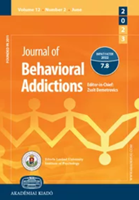Are there clinical, psychopathological and therapy outcomes correlates associated with self-exclusion from gambling?
Are there clinical, psychopathological and therapy outcomes correlates associated with self-exclusion from gambling?
Author(s): Juan C. Uríszar, Anahi Gaspar-Pérez, Roser Granero, Lucero Munguía, Milagros L. Lara-Huallipe, Bernat Mora-Maltas, Isabel Baenas, Mikel Etxandi, Mónica Gómez-Pena, Laura Moragas, Claudia Sisquellas, Fernando Fernández-Aranda, Susana Jiménez-MurciaSubject(s): Clinical psychology, Behaviorism, Studies in violence and power, Health and medicine and law
Published by: Akadémiai Kiadó
Keywords: gambling disorder; self-exclusion; sociodemographic characteristics; clinical profile; treatment outcome;
Summary/Abstract: Background and aims: Self-exclusion in gambling disorder (GD) is considered a measure to decrease the negative consequences of gambling behavior. Under a formal self-exclusion program, gamblers request to be banned from accessing to the gambling venues or online gambling. The aims of the present study are: 1) to determine sociodemographic characteristics of a clinical sample of seeking-treatment patients with GD who are self-excluded before arriving at the care unit; 2) to identify personality traits and general psychopathology of this clinical population; 3) to analyze the response to treatment, in terms of relapses and dropouts. Methods: 1,416 adults seeking treatment for GD, who are self-excluded completed screening tools to identify GD symptomatology, general psychopathology, and personality traits. The treatment outcome was measured by dropout and relapses. Results: Self-exclusion was significantly related to female sex and a high sociodemographic status. Also, it was associated with a preference for strategic and mixed gambling, longest duration and severity of the disorder, high rates of general psychopathology, more presence of illegal acts and high sensation seeking rates. In relation to treatment, self-exclusion was associated with low relapse rates. Conclusions: The patients who selfexclude before seeking treatment have a specific clinical profile, including high sociodemographic status, highest severity of GD, more years of evolution of the disorder and high emotional distress rates; however, these patients’ presents better response to treatment. Clinically, it could be expected that this strategy could be used as a facilitating variable in the therapeutic process.
Journal: Journal of Behavioral Addictions
- Issue Year: 12/2023
- Issue No: 2
- Page Range: 522-534
- Page Count: 13
- Language: English

